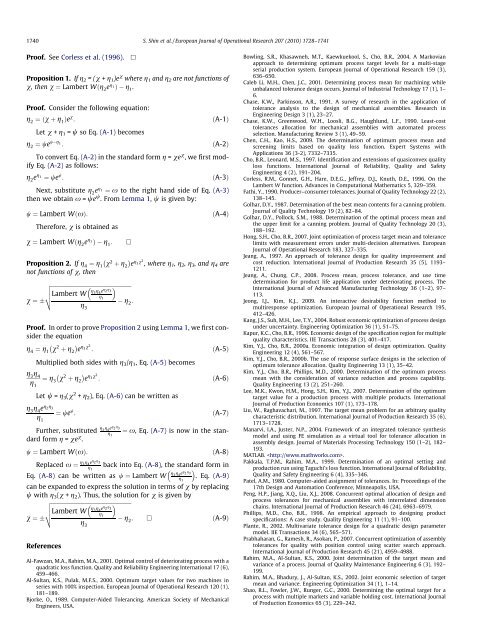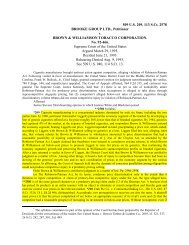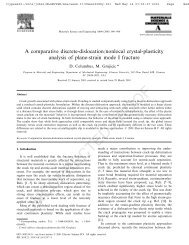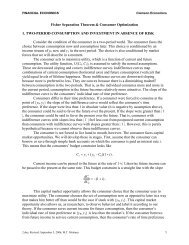Development of the parametric tolerance modeling and optimization ...
Development of the parametric tolerance modeling and optimization ...
Development of the parametric tolerance modeling and optimization ...
You also want an ePaper? Increase the reach of your titles
YUMPU automatically turns print PDFs into web optimized ePapers that Google loves.
1740 S. Shin et al. / European Journal <strong>of</strong> Operational Research 207 (2010) 1728–1741<br />
Pro<strong>of</strong>. See Corless et al. (1996). h<br />
Proposition 1. If g2 =(v + g1)e v where g1 <strong>and</strong> g2 are not functions <strong>of</strong><br />
v, <strong>the</strong>n v ¼ Lambert W g2eg ð 1Þ<br />
g1 .<br />
Pro<strong>of</strong>. Consider <strong>the</strong> following equation:<br />
g 2 ¼ðv þ g 1 Þe v : ðA-1Þ<br />
Let v + g1 = w so Eq. (A-1) becomes<br />
g 2 ¼ we w g 1: ðA-2Þ<br />
To convert Eq. (A-2) in <strong>the</strong> st<strong>and</strong>ard form g = ve v , we first modify<br />
Eq. (A-2) as follows:<br />
g 2 e g 1 ¼ we w : ðA-3Þ<br />
Next, substitute g 2 e g 1 ¼ x to <strong>the</strong> right h<strong>and</strong> side <strong>of</strong> Eq. (A-3)<br />
<strong>the</strong>n we obtain x = we w . From Lemma 1, w is given by:<br />
w ¼ Lambert WðxÞ: ðA-4Þ<br />
Therefore, v is obtained as<br />
v ¼ Lambert W g2e g ð 1Þ<br />
g1 :<br />
Proposition 2. If g4 ¼ g1 v2 þ g2 eg3v2 , where g1, g2, g3, <strong>and</strong> g4 are<br />
not functions <strong>of</strong> v, <strong>the</strong>n<br />
v ¼<br />
ffiffiffiffiffiffiffiffiffiffiffiffiffiffiffiffiffiffiffiffiffiffiffiffiffiffiffiffiffiffiffiffiffiffiffiffiffiffiffiffiffiffiffiffiffiffiffiffiffiffiffiffiffiffiffiffiffi<br />
Lambert W g3g4 e g2g v<br />
u<br />
3<br />
u<br />
t<br />
g1 :<br />
g 3<br />
g 2<br />
Pro<strong>of</strong>. In order to prove Proposition 2 using Lemma 1, we first consider<br />
<strong>the</strong> equation<br />
g4 ¼ g1 v2 þ g2 e g3v2 : ðA-5Þ<br />
g 3g 4<br />
g 1<br />
Multiplied both sides with g3/g1, Eq. (A-5) becomes<br />
¼ g3 v2 þ g2 e g3v2 : ðA-6Þ<br />
Let w = g 3(v 2 + g 2), Eq. (A-6) can be written as<br />
g 3g 4 e g 2g 3<br />
g 1<br />
¼ we w : ðA-7Þ<br />
Fur<strong>the</strong>r, substituted g3g4 e g2g3 g1 dard form g = ve v .<br />
¼ x, Eq. (A-7) is now in <strong>the</strong> stan-<br />
w ¼ Lambert WðxÞ: ðA-8Þ<br />
Replaced x ¼ g3g4 e g2g3 g back into Eq. (A-8), <strong>the</strong> st<strong>and</strong>ard form in<br />
1<br />
Eq. (A-8) can be written as w ¼ Lambert W g3g4 e g2g3 g . Eq. (A-9)<br />
1<br />
can be exp<strong>and</strong>ed to express <strong>the</strong> solution in terms <strong>of</strong> v by replacing<br />
w with g3(v + g2). Thus, <strong>the</strong> solution for v is given by<br />
ffiffiffiffiffiffiffiffiffiffiffiffiffiffiffiffiffiffiffiffiffiffiffiffiffiffiffiffiffiffiffiffiffiffiffiffiffiffiffiffiffiffiffiffiffiffiffiffiffiffiffiffiffiffiffiffiffi<br />
Lambert W<br />
v ¼<br />
g3g4 e g2g v<br />
u<br />
3<br />
u<br />
t<br />
g1 : ðA-9Þ<br />
References<br />
g 3<br />
g 2<br />
Al-Fawzan, M.A., Rahim, M.A., 2001. Optimal control <strong>of</strong> deteriorating process with a<br />
quadratic loss function. Quality <strong>and</strong> Reliability Engineering International 17 (6),<br />
459–466.<br />
Al-Sultan, K.S., Pulak, M.F.S., 2000. Optimum target values for two machines in<br />
series with 100% inspection. European Journal <strong>of</strong> Operational Research 120 (1),<br />
181–189.<br />
Bjorke, O., 1989. Computer-Aided Tolerancing. American Society <strong>of</strong> Mechanical<br />
Engineers, USA.<br />
Bowling, S.R., Khasawneh, M.T., Kaewkuekool, S., Cho, B.R., 2004. A Markovian<br />
approach to determining optimum process target levels for a multi-stage<br />
serial production system. European Journal <strong>of</strong> Operational Research 159 (3),<br />
636–650.<br />
Caleb Li, M.H., Chen, J.C., 2001. Determining process mean for machining while<br />
unbalanced <strong>tolerance</strong> design occurs. Journal <strong>of</strong> Industrial Technology 17 (1), 1–<br />
6.<br />
Chase, K.W., Parkinson, A.R., 1991. A survey <strong>of</strong> research in <strong>the</strong> application <strong>of</strong><br />
<strong>tolerance</strong> analysis to <strong>the</strong> design <strong>of</strong> mechanical assemblies. Research in<br />
Engineering Design 3 (1), 23–27.<br />
Chase, K.W., Greenwood, W.H., Loosli, B.G., Haughlund, L.F., 1990. Least-cost<br />
<strong>tolerance</strong>s allocation for mechanical assemblies with automated process<br />
selection. Manufacturing Review 3 (1), 49–59.<br />
Chen, C.H., Kao, H.S., 2009. The determination <strong>of</strong> optimum process mean <strong>and</strong><br />
screening limits based on quality loss function. Expert Systems with<br />
Applications 36 (3-2), 7332–7335.<br />
Cho, B.R., Leonard, M.S., 1997. Identification <strong>and</strong> extensions <strong>of</strong> quasiconvex quality<br />
loss functions. International Journal <strong>of</strong> Reliability, Quality <strong>and</strong> Safety<br />
Engineering 4 (2), 191–204.<br />
Corless, R.M., Gonnet, G.H., Hare, D.E.G., Jeffrey, D.J., Knuth, D.E., 1996. On <strong>the</strong><br />
Lambert W function. Advances in Computational Ma<strong>the</strong>matics 5, 329–359.<br />
Fathi, Y., 1990. Producer–consumer <strong>tolerance</strong>s. Journal <strong>of</strong> Quality Technology 22 (2),<br />
138–145.<br />
Golhar, D.Y., 1987. Determination <strong>of</strong> <strong>the</strong> best mean contents for a canning problem.<br />
Journal <strong>of</strong> Quality Technology 19 (2), 82–84.<br />
Golhar, D.Y., Pollock, S.M., 1988. Determination <strong>of</strong> <strong>the</strong> optimal process mean <strong>and</strong><br />
<strong>the</strong> upper limit for a canning problem. Journal <strong>of</strong> Quality Technology 20 (3),<br />
188–192.<br />
Hong, S.H., Cho, B.R., 2007. Joint <strong>optimization</strong> <strong>of</strong> process target mean <strong>and</strong> <strong>tolerance</strong><br />
limits with measurement errors under multi-decision alternatives. European<br />
Journal <strong>of</strong> Operational Research 183, 327–335.<br />
Jeang, A., 1997. An approach <strong>of</strong> <strong>tolerance</strong> design for quality improvement <strong>and</strong><br />
cost reduction. International Journal <strong>of</strong> Production Research 35 (5), 1193–<br />
1211.<br />
Jeang, A., Chung, C.P., 2008. Process mean, process <strong>tolerance</strong>, <strong>and</strong> use time<br />
determination for product life application under deteriorating process. The<br />
International Journal <strong>of</strong> Advanced Manufacturing Technology 36 (1–2), 97–<br />
113.<br />
Jeong, I.J., Kim, K.J., 2009. An interactive desirability function method to<br />
multiresponse <strong>optimization</strong>. European Journal <strong>of</strong> Operational Research 195,<br />
412–426.<br />
Kang, J.S., Suh, M.H., Lee, T.Y., 2004. Robust economic <strong>optimization</strong> <strong>of</strong> process design<br />
under uncertainty. Engineering Optimization 36 (1), 51–75.<br />
Kapur, K.C., Cho, B.R., 1996. Economic design <strong>of</strong> <strong>the</strong> specification region for multiple<br />
quality characteristics. IIE Transactions 28 (3), 401–417.<br />
Kim, Y.J., Cho, B.R., 2000a. Economic integration <strong>of</strong> design <strong>optimization</strong>. Quality<br />
Engineering 12 (4), 561–567.<br />
Kim, Y.J., Cho, B.R., 2000b. The use <strong>of</strong> response surface designs in <strong>the</strong> selection <strong>of</strong><br />
optimum <strong>tolerance</strong> allocation. Quality Engineering 13 (1), 35–42.<br />
Kim, Y.J., Cho, B.R., Phillips, M.D., 2000. Determination <strong>of</strong> <strong>the</strong> optimum process<br />
mean with <strong>the</strong> consideration <strong>of</strong> variance reduction <strong>and</strong> process capability.<br />
Quality Engineering 13 (2), 251–260.<br />
Lee, M.K., Kwon, H.M., Hong, S.H., Kim, Y.J., 2007. Determination <strong>of</strong> <strong>the</strong> optimum<br />
target value for a production process with multiple products. International<br />
Journal <strong>of</strong> Production Economics 107 (1), 173–178.<br />
Liu, W., Raghavachari, M., 1997. The target mean problem for an arbitrary quality<br />
characteristic distribution. International Journal <strong>of</strong> Production Research 35 (6),<br />
1713–1728.<br />
Manarvi, I.A., Juster, N.P., 2004. Framework <strong>of</strong> an integrated <strong>tolerance</strong> syn<strong>the</strong>sis<br />
model <strong>and</strong> using FE simulation as a virtual tool for <strong>tolerance</strong> allocation in<br />
assembly design. Journal <strong>of</strong> Materials Processing Technology 150 (1–2), 182–<br />
193.<br />
MATLAB. .<br />
Pakkala, T.P.M., Rahim, M.A., 1999. Determination <strong>of</strong> an optimal setting <strong>and</strong><br />
production run using Taguchi’s loss function. International Journal <strong>of</strong> Reliability,<br />
Quality <strong>and</strong> Safety Engineering 6 (4), 335–346.<br />
Patel, A.M., 1980. Computer-aided assignment <strong>of</strong> <strong>tolerance</strong>s. In: Proceedings <strong>of</strong> <strong>the</strong><br />
17th Design <strong>and</strong> Automation Conference, Minneapolis, USA.<br />
Peng, H.P., Jiang, X.Q., Liu, X.J., 2008. Concurrent optimal allocation <strong>of</strong> design <strong>and</strong><br />
process <strong>tolerance</strong>s for mechanical assemblies with interrelated dimension<br />
chains. International Journal <strong>of</strong> Production Research 46 (24), 6963–6979.<br />
Phillips, M.D., Cho, B.R., 1998. An empirical approach to designing product<br />
specifications: A case study. Quality Engineering 11 (1), 91–100.<br />
Plante, R., 2002. Multivariate <strong>tolerance</strong> design for a quadratic design parameter<br />
model. IIE Transactions 34 (6), 565–571.<br />
Prabhaharan, G., Ramesh, R., Asokan, P., 2007. Concurrent <strong>optimization</strong> <strong>of</strong> assembly<br />
<strong>tolerance</strong>s for quality with position control using scatter search approach.<br />
International Journal <strong>of</strong> Production Research 45 (21), 4959–4988.<br />
Rahim, M.A., Al-Sultan, K.S., 2000. Joint determination <strong>of</strong> <strong>the</strong> target mean <strong>and</strong><br />
variance <strong>of</strong> a process. Journal <strong>of</strong> Quality Maintenance Engineering 6 (3), 192–<br />
199.<br />
Rahim, M.A., Bhadury, J., Al-Sultan, K.S., 2002. Joint economic selection <strong>of</strong> target<br />
mean <strong>and</strong> variance. Engineering Optimization 34 (1), 1–14.<br />
Shao, R.L., Fowler, J.W., Runger, G.C., 2000. Determining <strong>the</strong> optimal target for a<br />
process with multiple markets <strong>and</strong> variable holding cost. International Journal<br />
<strong>of</strong> Production Economics 65 (3), 229–242.
















